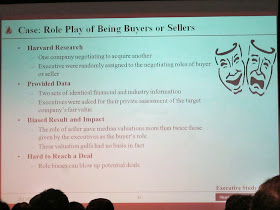Before the talk, Dr. Mark Lee told us a story about Teddy Roosevelt's Presidential Campaign. During the election campaign, three million copies of leaflet for the election was printed but it was without photo copyright from Moffett Studios. The photo could cost the campaing US$1 per reproduction and the studio was financially hard up. However, George Perkins (Campaign Manager) thought in the other way to propose Moffett Studios as a sponsor to promote themselves for US$250. The due was made! George changed "the problem of focus on price only" to "the value of publicity and recognition".
Six Common Mistakes of Negotiation were discussed.
Mistake 1 - Neglecting the Other Side's Problem
Dr. Lee quoted Dr. William Ury (Negotiation adviser and mediator, Harvard Law School) Golden Bridge Strategy. It needed to consider both side to build a bridge. Always try to put yourself in the other person's shoes and to understand in depth what the other side really wants out of the deal. Influence power come from Understanding.
Dr. Lee introduced the Money Splitting Game and found that some situation was irrational rejection to "greedy" person. Then Felix Rohatyn (Former Managing Partner, Lazard Freres Investment Bank) statement was quoted that was "Most deals are 50% emotion and 50% economics (price)." Back to the game, people would consider "relative results", "perceived fairness", "self-image" and "reputation".
Dr. Lee said the important to be able to distinguish between positions and interests.
Focused on each other's position (the what) and Not on each other's interest (the why)
The following photo pointed out three elements inside a negotiation that was "Issues", "Positions" and "Interests".
Mistake 4 - Searching too Hard for Common Ground
Dr. Lee explained the differences of interest giving the value. He quoted a case about incompatible boundary (the Sinai) between Egypt and Israel. Since they had no common ground but different interests. The Israeli cared more about security and the Egyptian cared more about sovereignty. The solution was a demilitarized zone under the Egyptian flag. It is a good example of "Differences Make up the Deal".
Mistake 5 - Neglecting No-Deal Alternatives
Dr. Lee introduced the term BATNA that was Best Alternative to a Negotiated Agreement. It meant to consider the consequence of no deal. An interested example was quoted that employee would like to negotiate their salary with boss. A gun or a terrific job offered from a serious competitor of your company.
Mistake 6 - Failing to Correct for Skewed Vision
In order to avoid bias, role play of being buyers or sellers to think the deal was recommended.
Finally, Dr. Lee concluded "Understand and influence the other side's such that what it chooses is what you want" and he repeated Daniele Vare's statement "Negotiation is the art of letting them have your way."
Some reference books were suggested by Dr. Lee.
Before the group discussion, Dr. Lee used NLP method to give us an exercise to choose Two of the most common mistakes and One of the least common mistake.
Reference:
The Centre for Logistics Technologies and Supply Chain Optimization, CUHK - http://www.logitsco.cuhk.edu.hk/
HKSTP - www.hkstp.org











沒有留言:
發佈留言